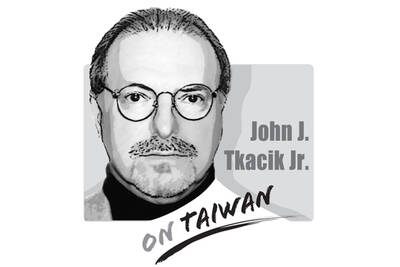Geopolitical competition has turned the semiconductor industry into a key sector being contested globally. As a US-China technology dispute continues to heat up, Washington is implementing a “small yard and high wall” technology control strategy in an attempt to slow China’s development of semiconductors, and to prevent high-end artificial intelligence (AI) chips from being used for Chinese military purposes. On the other hand, Beijing is trying to break through that wall, using talent mobility and AI as shortcuts.
China’s semiconductor industry faces four major bottlenecks: semiconductor equipment for advanced manufacturing processes, electronic design automation (EDA) software for semiconductor design, high-end AI chips and semiconductor talent.
In particular, the US’ restriction on exports of extreme ultraviolet equipment has made it more difficult for China to obtain technology more advanced than the 7-nanometer manufacturing process, which has become a key factor in constraining its development.
By adopting the technology of optical proximity correction, China has attempted to improve the low yield rate of deep ultraviolet multiple exposure processes caused by the optical proximity effect. It has also utilized AI to enhance the accuracy and efficiency of optical proximity correction in an attempt to break through the technological bottleneck and the US blockade.
The US “small yard and high wall” blockade focuses on the extreme ultraviolet equipment and deep ultraviolet lithography equipment, as well as high-end AI chips and EDA software.
It also prohibits US citizens from assisting China in the development of high-end chips. China has responded to the US controls in a roundabout way, through pre-stocking, shell companies and even smuggling.
Chinese start-up SEIDA has made significant progress in optical proximity correction through the transfer of core EDA talent from Siemens, demonstrating that in the face of US bans, the outflow of talent would result in a spillover of technology to China.
Taiwan must be careful in its response to this situation to ensure that it can maintain a leading position in the complex US-China-Taiwan “silicon triangle.”
The government should not only develop a list of national core and critical technologies to bolster its mastery of semiconductor technology, but also cooperate with international allies in a multilateral export control system to prevent the outflow of advanced chip technology to China, as well as the illegal transfer or mobility of key semiconductor equipment, technology and talent, to protect core technologies and outstanding semiconductor talent.
Recently, the EU has pushed for “de-risking” its economy from China and strengthening export controls to prevent sensitive dual-use technologies from being leaked to China through overseas investments. Meanwhile, Taiwan should enhance the cultivation and retention of semiconductor talent, bolster independent innovation in IC design and continue to develop emerging semiconductor technologies such as silicon photonics, small chip packaging and AI applications, to ensure the competitiveness of Taiwan’s semiconductor industry, and to push the industry to new peaks.
Liao Ming-hui is an assistant researcher at the Chung-Hua Institution for Economic Research.
Translated by Eddy Chang

On May 7, 1971, Henry Kissinger planned his first, ultra-secret mission to China and pondered whether it would be better to meet his Chinese interlocutors “in Pakistan where the Pakistanis would tape the meeting — or in China where the Chinese would do the taping.” After a flicker of thought, he decided to have the Chinese do all the tape recording, translating and transcribing. Fortuitously, historians have several thousand pages of verbatim texts of Dr. Kissinger’s negotiations with his Chinese counterparts. Paradoxically, behind the scenes, Chinese stenographers prepared verbatim English language typescripts faster than they could translate and type them
More than 30 years ago when I immigrated to the US, applied for citizenship and took the 100-question civics test, the one part of the naturalization process that left the deepest impression on me was one question on the N-400 form, which asked: “Have you ever been a member of, involved in or in any way associated with any communist or totalitarian party anywhere in the world?” Answering “yes” could lead to the rejection of your application. Some people might try their luck and lie, but if exposed, the consequences could be much worse — a person could be fined,
Xiaomi Corp founder Lei Jun (雷軍) on May 22 made a high-profile announcement, giving online viewers a sneak peek at the company’s first 3-nanometer mobile processor — the Xring O1 chip — and saying it is a breakthrough in China’s chip design history. Although Xiaomi might be capable of designing chips, it lacks the ability to manufacture them. No matter how beautifully planned the blueprints are, if they cannot be mass-produced, they are nothing more than drawings on paper. The truth is that China’s chipmaking efforts are still heavily reliant on the free world — particularly on Taiwan Semiconductor Manufacturing
Last week, Nvidia chief executive officer Jensen Huang (黃仁勳) unveiled the location of Nvidia’s new Taipei headquarters and announced plans to build the world’s first large-scale artificial intelligence (AI) supercomputer in Taiwan. In Taipei, Huang’s announcement was welcomed as a milestone for Taiwan’s tech industry. However, beneath the excitement lies a significant question: Can Taiwan’s electricity infrastructure, especially its renewable energy supply, keep up with growing demand from AI chipmaking? Despite its leadership in digital hardware, Taiwan lags behind in renewable energy adoption. Moreover, the electricity grid is already experiencing supply shortages. As Taiwan’s role in AI manufacturing expands, it is critical that